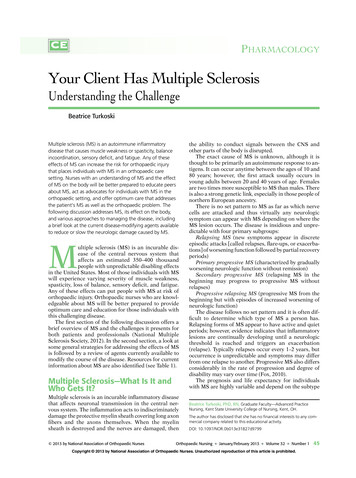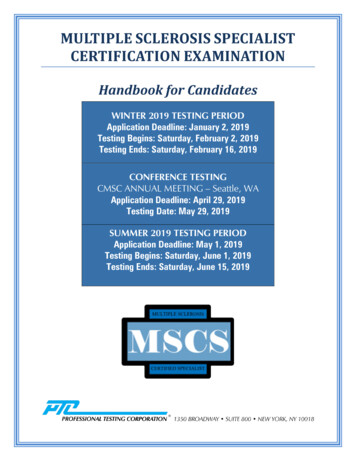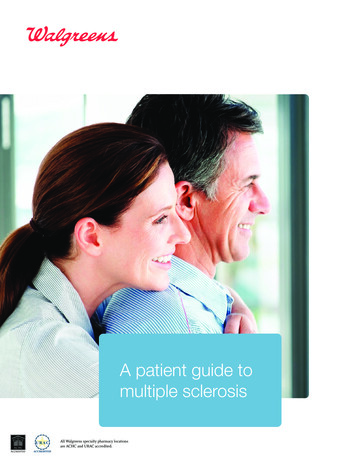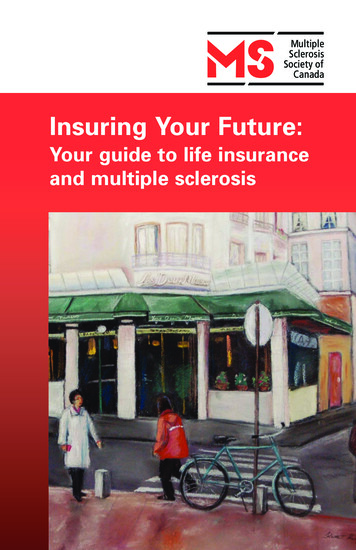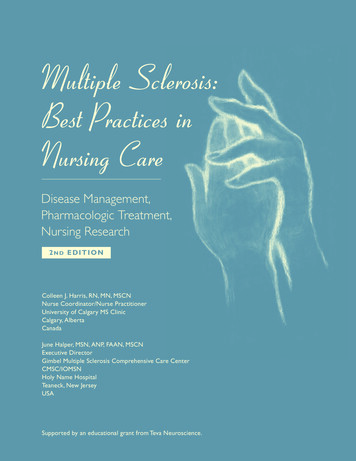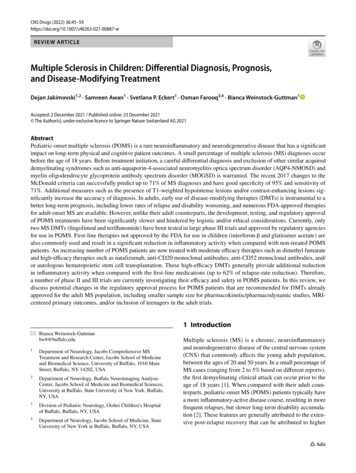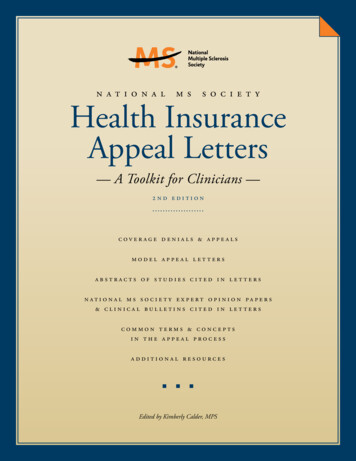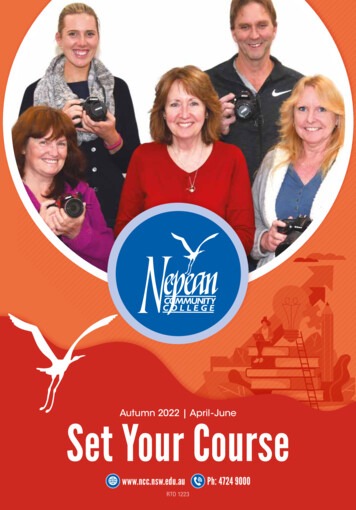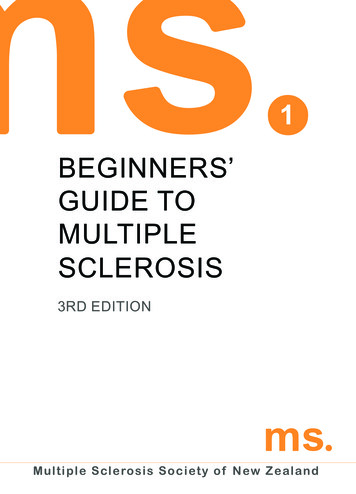
Transcription
11BEGINNERS’GUIDE TOMULTIPLESCLEROSIS3RD EDITIONMultiple Sclerosis Society of New Zealand
CONTENTSIntroduction3What is Multiple Sclerosis?4Types of MS5Symptoms of MS6Who gets Multiple Sclerosis?7What causes Multiple Sclerosis?8How is Multiple Sclerosis diagnosed?9What treatments are available?10Complementary and Alternative Medicine12Adjusting to the diagnosis14What can I do?16The future18Pregnancy and Multiple Sclerosis19Sources of support20Glossary23Contact details33Beginner’s Guide to MS Page 1
AUTHORWritten by Lynne Roberts with the assistance of Dr Tom Miller.ACKNOWLEDGEMENTSThe MS Society of New Zealand would like to thank those that contributedto this book, including the Multiple Sclerosis International Federation (MSIF)for giving us permission to reproduce graphics and the National MS Society(USA) for permission to use sections of their sourcebooks.Thank you to Lynne Roberts and Tom Miller. Thanks also to the MSSNZInformation Series Review Team.Beginner’s Guide to MS: 2nd edition published in 2004 by the MultipleSclerosis Society of NZ with the support of the James Searle SayFoundation. Reprinted in 2006.Multiple Sclerosis Society of New Zealand IncorporatedPO Box 32124Christchurch 8147NEW ZEALANDPhoneEmailWebsite0800 MS LINE or 0800 675 463info@msnz.org.nzwww.msnz.org.nz Multiple Sclerosis Society of NZ Inc 2006ISSN: 1176-4473ISBN: 0-908982-02-X
INTRODUCTIONWe have a very important message for you: Don’t Panic.Multiple Sclerosis does not necessarily produce serious disability.With a new generation of drug therapies becoming available, it’s apotentially treatable disorder. The future for those newly diagnosedis looking more favourable with each new development, althoughavailable therapies are only partially effective at present.This booklet will answer many of your commonly-asked questionsand, while some matters are only briefly touched on here, otherinformation booklets in this series deal with particular issues inmore depth. All are available on request from your local field officeror from the MS Society of NZ.In addition, our National Information Centre and most Regional MSSocieties have a comprehensive library of books and videosavailable, written and produced by people from a range of viewpointsfrom health professionals to people with MS.Please make the most of these opportunities to learn about MS aseducation is empowering on so many levels. We trust you find theseNZ produced booklets helpful.Beginner’s Guide to MS Page 3
WHAT IS MULTIPLESCLEROSIS?Multiple sclerosis (or MS as it is often called) is a disorder of thecentral nervous system (CNS) - the brain, spinal cord and optic nerves.The central nervous system is responsible for our conscious andunconscious functioning including movement and the response tosensations such as sight, touch and hearing. It directs these functionsby sending its instructions in the form of electrical impulses to theappropriate sites along nerve fibres. Nerve fibres are coated in aprotective insulating covering called the myelin sheath that serves avery similar function to the coating around electrical wires. Myelin isimportant in speeding electrical conduction along nerve fibres and ininsulating nerve fibres from one another.The term multiple sclerosisrefers to multiple areas ofscarring (sclerosis) scatteredthrough the brain and spinalcord. The scars are the result ofhealing patches ofinflammation. These are thebasic cause of damage to nervefibres and of the suddenlyappearing symptoms that arereferred to as an attack orrelapse. Patches of inflammationheal spontaneously over severalPage 4 Beginner’s Guide to MS
weeks or months when symptoms may resolve completely or residualimpairment may result.The inflammation causes damage particularly to the insulating myelinsheath covering nerve fibres but also damages the nerve fibres(axons) themselves. In MS the typical damage is often referred toas “demyelinating”. The nature of the symptoms and their severitydepends partly on the site of the patch of inflammation (or lesion) andpartly on its nature and intensity.The course of MS varies widely from person to person. Some peoplewill only ever experience mild symptoms over their lifetime while otherswill have relapses followed by incomplete remission when disabilitymay worsen in a stepwise fashion with each relapse experienced.A number of persons experience slowly progressive worsening ofdisability over many months or years. There is uncertainty how muchof this progressive process is due to low-grade inflammation and howmuch to loss of previously damaged nerve fibres.TYPES OF MSIn general three typical patterns of MS can berecognised:RELAPSING-REMITTING MS: relapses with a flare up of old symptomsor the development of new symptoms (over several days or weeks) arefollowed by a remission with resolution or reduction of symptoms.SECONDARY-PROGRESSIVE MS: after an initial course of relapsing/remitting MS there is the development of slowly progressive disability(over many years). In this phase relapses may also still occur.PRIMARY-PROGRESSIVE MS: in about 10% of cases, from the beginning, there is slow progressive worsening of symptoms and disabilitywithout distinct attacks.Beginner’s Guide to MS Page 5
SYMPTOMS OF MSIn MS the condition and symptoms are unpredictable and vary fromperson to person. Symptoms are not only different in different peoplebut typically vary in the same person from time to time as differentareas of the central nervous system become inflamed and scarred.Common symptoms include:Weakness or in-coordination of the limbs Impaired balance or instability walking Sensory disturbances Blurred or double vision Impaired urinary or sexual function Cognitive dysfunction such as impaired memory orconcentration General fatigue NOTE: a person with MS will usually experience more than onesymptom but NOT necessarily all of them.Page 6 Beginner’s Guide to MS
WHO GETS MULTIPLESCLEROSIS?In New Zealand, about one in every 1,000 to 2,000 develops MSwith approximately 2500 people affected.It is more common in:YOUNG ADULTS: symptoms usually appear between the ages of 20and 50 with a peak in the early 30’s.WOMEN: Women are affected approximately twice as often as men.CAUCASIANS: MS is more prevalent in Caucasians (people withancestry from Northern Europe), than any other racial group. It israrely found in Maori and Polynesian people and is uncommon inAsian peopleNEAR RELATIVES of those with MS have an increased risk. Havinga first-degree relative, (mother, father, sibling,) with MS increasesthe chances of having it from approximately one in every thousandpeople to 30 in every thousand, but it is important to note that thegreat majority of people with an affected first-degree relative do notdevelop MS.MS is not contagious or infectious; it is not possible to contract itfrom close contact with a person with MS.Beginner’s Guide to MS Page 7
WHAT CAUSESMULTIPLE SCLEROSIS?The cause of MS is still not known. Both genetic and environmentalfactors are important but how they interact to produce episodes oflocalised inflammation over many years is not clear. MS is widelyregarded as an autoimmune disease in which the body produces amisdirected immune system attack on its own tissue (in this case, themyelin sheath that protects the axons), but that has never been firmlyestablished. A reaction to a virus hidden in the central nervous systemhas been long suspected but also not proven. In persons with MS theimmune system appears to be normal in all other respects.MS is not a hereditary disorder in the sense of being passed directlyfrom parent to child. The increased risk in close family membersis not attributable to a single gene but is related to several geneswhose function is not well understood – some probably influenceimmune reactions.A striking environmental feature is the increase in prevalence of MS inhigher latitudes both above and below the equator. In NZ, for example,the prevalence in the South Island is approximately twice that inthe upper half of the North Island. The pattern of migration fromNorthern Europe may contribute to that distribution but undeterminedenvironmental factors are most important. Among many possibilities,exposure early in life to a virus infection that has a long-term effecton immune responses is thought most likely. However, none of thenumerous viruses suspected can be directly linked at present.Page 8 Beginner’s Guide to MS
HOW IS MULTIPLESCLEROSIS DIAGNOSED?Ideally, a neurologist or specialist physician should confirm thediagnosis of MS. The basis of a diagnosis of MS remains a carefulneurological assessment including analysis of symptoms andphysical examination. It depends on the demonstration of typicalfeatures and exclusion of other disorders that may produce similarsymptoms.Diagnostic tests have an important role and include:Magnetic Resonance (MR) scanning of the brain and spinalcord. This has been a major advance in the diagnosis ofMS but the changes seen are not specific for MS andage-related changes may cause confusion. Lumbar Puncture to examine the cerebrospinal fluid (CSF). Evoked Potentials which measure electrical conductionthrough CNS pathways are not commonly used now thatMR scanning is widely available. Beginner’s Guide to MS Page 9
WHAT TREATMENTSARE AVAILABLE?While there currently is no ‘cure’ for MS, treatments are available todeal with different aspects of the disease. These can be consideredin four main categories.1. TREATMENT OF RELAPSESAcute flare-ups or relapses are usually managed by the administrationof corticosteroids (eg: methylprednisolone or prednisone), which canshorten the duration of an attack and lesson its severity. These can betaken either orally or intravenously.2. DISEASE MODIFYING THERAPY – PREVENTINGRELAPSESA number of agents generally classed as ‘disease modifying agents’are now capable of reducing the number of relapses and thedevelopment of new brain lesions seen on MR scans. The mostwidely used are described as immunomodulating agents and includebeta-interferon (Avonex , Betaferon , and Rebif ), and glatirameracetate (Copaxone ). These treatments are expensive, must be givenby regular injection and must be continued indefinitely to maintaineffect. Immune suppressing agents such as mitoxantrone (Novantrone)also have a place. In New Zealand only Betaferon and Avonex arecurrently funded by Pharmac and access to treatment is restricted topersons with frequent relapses and significant residual disability. Yourneurologist can advise you if you qualify for this treatment.Page 10Beginner’s Guide to MS
3. MANAGEMENT OF SYMPTOMSTherapy is available to relieve many of the symptoms associated withMS. Treatment options can include physiotherapy and medication.4. REHABILITATIONWhile it may not be possible to improve all lost function, persons withMS should try to optimise their physical, mental and social condition.After an exacerbation there may be the need for rehabilitation. Duringremission periods people with MS should participate in a maintenancetherapy programme to achieve and sustain their optimum physicalcondition. This may involve physiotherapy, stretching, coordinationexercises, speech and swallowing instruction. It may also includemedication, good nutrition and counselling. There may be the need forlifestyle changes (both social and occupational).Beginner’s Guide to MS Page 11
COMPLEMENTARY ANDALTERNATIVE MEDICINESome people believe that if conventional medicine cannot providea cure for MS, then perhaps alternative medicine will do so. Othersfind that seeking more holistic therapies allows them to feel they arecontrolling their MS.Caution should be the keyword, particularly when the use of herbalremedies is being contemplated. A number of these remedies havebeen shown to interact with prescribed drugs and adverse effectsare not uncommon. Specifically a number of these remedies claim to‘enhance’ the immune system. As the principal problem in MS is analready over enhanced immune response it is particularly importantto tell your doctor if you are taking or contemplating taking any‘natural’ or ‘herbal’ remedies. Some of these can react badly withprescribed drugs and are often promoted by people with little or nounderstanding of the disease. Some cautions and incompatibilitiesassociated with herbal products have been widely publicised recentlyand reputable reference sources can be consulted.Medsafe is the New Zealand Medicines and Medical Devices SafetyAuthority. It is a business unit of the Ministry of Health and is theauthority responsible for the regulation of therapeutic products inNew Zealand.Page 12Beginner’s Guide to MS
Medsafe regulates products used for a therapeutic purpose. Thisincludes: Medicines Related products Herbal remedies Medical devices Controlled drugs used as medicinesMedsafe can provide useful information about particular productsand therapies. Contact details for Medsafe and the Ministry of Healthare located in the section Sources of Support. The Rocky MountainMS Centre CAM website can also be helpful if you have internetaccess, and the MS Society can provide information on specifictopics.Be aware that information you read on the Internet or in a newspapermay not necessarily be correct. Be particularly wary of any productor information that claims to be a cure for MS; if it’s genuine andhas been scientifically proven, your neurologist will know of it. Don’tforget that MS can go into remission suddenly and ‘miraculously,’for no apparent reason, so apportioning success to any particulartreatment can be misleading.Beginner’s Guide to MS Page 13
ADJUSTING TOTHE DIAGNOSISIn coming to terms with a diagnosis of MS one of the most difficultaspects is its unpredictability. Receiving a diagnosis of MS canalter the way you look at life. It may make you feel that you havelost control or that your future is uncertain. Don’t despair. Everyonegoes through stages of adjusting to major life changes and theseprocesses are entirely normal, although the intensity of feeling andlength of those stages will vary from person to person.Some people will feel relief at finally having a diagnosis. Finally theywill have an explanation for the puzzling and sometimes frighteningsymptoms they have been experiencing. More than that they may berelieved to find their symptoms are not caused by a life threateningdisease.Others may react differently, becoming fearful of what life will hold.Do they give up their job, alter any plans to start a family or havemore children? They may fear the reaction of their partner and familyand grieve for their perceived altered relationships. All these feelingsare very natural and will become less overwhelming with time andsupport.SPREADING THE NEWSDon’t be afraid to tell those closest to you about your MS; they will beyour strongest supporters. Acknowledge though that they will passPage 14Beginner’s Guide to MS
through their own stages of acceptance, just as you will, so try toalso be aware of their needs. If you share your feelings about havingMS you will find it easier to accept their support and you can growtogether in strength and understanding.Children should be told at a level they can understand and this mayneed to be repeated and expanded on as they grow older. It’s veryimportant that children are reassured that their behaviour has notcaused your MS and that it’s not contagious - they can’t catch it fromyou. You’ll find children tend to be very accepting and love you forwho you are.The same can be said for friends. They can do what they do best, besupportive and loving when they know what’s going on. They mayhave witnessed your symptoms and be already worried about thecause. Remember, everyone’s imagination is almost invariably worsethat the reality so put those closest to you out of their misery andconfide in them. It’s the relationships in our lives that get us throughnot only the good times but the difficult, as well.You may have concerns about telling your employers, worryingit could affect your employment. Remember, they are obliged torespect your privacy and not tell others about it. By law you cannotbe fired just because you have developed an illness. In many casesemployers are very understanding and with consultation may makesmall but significant changes to your work environment to allow youto keep working productively.Beginner’s Guide to MS Page 15
WHAT CAN I DO?The best thing you can do for yourself is to live a healthy life style thatgives you good quality of life. You may be tempted to fall into the trapof thinking that just because there is currently no cure for MS thenit doesn’t matter what else you do. It’s simply not true. If you smokeor drink to excess, then you are just as likely to suffer from a rangeof adverse health effects, regardless of whether you have MS or not.Maintaining a healthy body gives you the best chance of living longand well.REST AND EXERCISEStay active, with reasonable rest. Recognise fatigue and rest whenyou need to. This may be short periods with your feet up or onespecific time period set aside each day. If you are working it maymean taking an extended break mid-morning and mid-afternoon atyour employer’s discretion. Try to avoid pushing yourself too hard asthis may make your symptoms temporarily worse. You don’t have tobelong to a gym to exercise. Walk, swim, move to music, join an exercise class - whatever you enjoy. There is good evidence that regularexercise improves overall health and energy levels.DIETWhile there is widespread belief that diet can alter the course of MSthere is no scientific proof to back this up. Eat a sensible diet andyou will feel better within yourself but don’t expect it to cure you.Don’t fall into the trap of thinking that you need to swallow bottles ofvitamins. In a healthy diet there is no evidence to suggest additionalPage 16Beginner’s Guide to MS
vitamins are necessary or of any benefit; as for any healthy lifestyle,limiting alcohol and caffeine intake is also recommended.TEMPERATUREBe cautious of overheating, as this could increase fatigue andmay make your symptoms temporarily worse. Bear in mind thatheat could be a factor in a worsening of your symptoms and avoidactivities such as saunas or hot baths if heat affects you.BE POSITIVEThe best way to deal with your life with MS is to be flexible. Trysomething new; there are many things you can enjoy in life, soconcentrate on what you can do rather than what you can’t. Somepeople may say ‘It’s just not fair!’ No, it’s not, but no one said lifehas to be. In time you will be able to find a place where MS can fitinto your life without allowing it to dominate. You may not believe thisto be possible so soon after a diagnosis but it does come with time.Remember, MS can only change you if you allow it to; you’re still thesame person today as you were the day before the diagnosis.Beginner’s Guide to MS Page 17
THE FUTUREYour life with MS will be what you make of it. Just as everyone isunique, everyone’s MS is also unique to them. Neurologists areunable to predict the future as it may take years for a pattern toevolve; in many cases this is only evident after looking back withretrospective evaluation.Although the progress of the disease in any one person cannot bepredicted with any accuracy, the statistics are encouraging: Many people with relapsing remitting MS have many yearsbetween attacks. Long term disability is more likely to occur in those withsecondary progressive MS rather than relapsing remittingMS.MAKING DECISIONSThink carefully before making any major decisions about your lifewhen you are newly diagnosed with MS. This is when you need timeto come to terms with it and should try to live as normal a life aspossible.Decisions about starting a family or having more children need to bewell thought out when you have had time to consider your options.Page 18Beginner’s Guide to MS
PREGNANCY ANDMULTIPLE SCLEROSISBecause of the typical age of onset of MS, this is often a time whenwomen are starting a family or contemplating having more children.MS should be taken in account just as you would any other factors inthis decision.Several issues arise when people with MS plan to have children.A person with MS has as increased risk of having a childwho will develop MS but the risk is small and not usuallysufficient to dissuade couples from starting a family. Relapses are less likely to occur while pregnant, but thereis an increased risk of a relapse in the three monthsfollowing a pregnancy. Overall, pregnancy does not have a significant effect onthe course of MS. Pregnancy is best avoided while taking disease modifyingtherapies. Consult your GP about family planning and pregnancy,particularly if you are taking any medication for your MS. Beginner’s Guide to MS Page 19
SOURCES OF SUPPORTThe MS Society may put you in contact with a regional field officerwho can offer support and information. They can give advice onall matters concerning MS and arrange social groups, exerciseclasses, support meetings and referrals. The range of servicesoffered varies between regional societies. Contact details foryour local society are located at the end of this book. Meetingpeople through the MS Society can be very reassuring, as youmay be surprised to find how many people have MS that you wereunaware of. A lot of people with MS have ‘invisible’ symptoms andlead normal lives. Some people find support groups helpful as anoccasion where they can share their experiences and learn howothers deal with MS.Your GP is your main health care provider, so do your best tolocate a GP with an interest in MS. It’s important to communicateyour worries and symptoms as clearly as possible so you canget appropriate assistance. Your GP will be able to refer you to aneurologist or other specialist (eg. physiotherapist) if there arequestions and concerns. Ideally, the diagnosis of MS should beconfirmed by a neurologist or specialist physician.The following information and referrals are available from yourlocal GP. These are invaluable sources of help, supplies, andgovernmental funding should you require their services. Not onlyare they very important; they’re completely free.Page 20Beginner’s Guide to MS
COMMUNITY OCCUPATIONAL THERAPISTA Community OT knows how to minimise the difficulties a personwith MS may encounter, and how to access funding from regionalagencies for aids such as handrails or tools for ease of living andsafety around the home. They are able to submit applications to dowith mobility and make referrals for vehicle modifications and toDisability Support Link (DSL) who assess and fund personal care andhousekeeping hours.COMMUNITY DRIVING ASSESSORThis person will discuss and approve vehicle adaptations should yourequire any. If necessary they can arrange for trials of different handor foot controls and can assist in overcoming a host of vehicle-relateddifficulties.COMMUNITY PHYSIOTHERAPISTAvailable to provide home visits to help with issues relating tochanges in the body. They can advise on exercises and ways ofreducing the strain on weakening muscles.Referrals to Speech Therapists, Urology Clinics and any other supportservices can also be accessed through your GP.INTERNET RESOURCESThe Internet provides a great deal of information about MS, butthe quality and accuracy of the information can vary. Some usefulwebsites are listed below.Beginner’s Guide to MS Page 21
MS SocietiesMS Society of New Zealand: www.msnz.org.nzMultiple Sclerosis International Federation: www.msif.orgAustralia: www.mssociety.com.auUnited Kingdom: www.mssociety.org.ukUnited States: www.nmss.orgMedicationMedsafe: www.medsafe.govt.nzPHARMAC: www.pharmac.govt.nzWork and Incomewww.workandincome.govt.nzCarersCarers.net – the online resource for carers: www.carers.net.nzDisabilityWeka, What Everyone Keeps Asking – about disability(contact by phone - 0800 17 1981): www.weka.net.nzComplementary and Alternative TherapyRocky Mountain MS Centre: www.ms-cam.orgPage 22Beginner’s Guide to MS
GLOSSARYAaAcute Having rapid onset, usually withrecovery; not chronic or long lasting.Antibodies Proteins produced by theimmune system in response to antigenson foreign organisms or other substances.Antibodies attach selectively to theirspecific antigens as part of the processby which foreign material is cleared fromthe body by the immune system.Antigen A substance that stimulatesthe production of an antibody. Commonantigens include protein components ofviruses and bacteria, and other foreignsubstances.Ataxia The incoordination andunsteadiness that results from the brain’sfailure to regulate the body’s posture andthe strength and directionof limb movements. Ataxia is most oftencaused by damage to the cerebellum.Autoimmune disease A process inwhich the body’s immune systemcauses illness by inappropriatelyattacking healthy cells, or tissues inthe body. Multiple sclerosis is widelybelieved to be an autoimmune disease,but that is not firmly established.Avonex trade name for Interferonbeta 1-a.Axon The core nerve fibre that transmitselectrical signals from a nerve cell to othernerve cells or to muscles. It is covered bythe myelin sheath which speeds electricalconduction and insulates the axon fromother nerve fibres.BbBabinski sign A neurological sign,common in MS in which stroking theoutside sole of the foot with a pointedobject causes an upward (extensor)movement of the big toe rather than thenormal downward (flexor) movement ofthe big toe. It results from damage tomotor pathways in the CNS.Benign MS Some people with relapsing/remitting MS are described as havinga benign form of the disease. It is notpossible to diagnose someone initiallyas having this form of MS, as it is only bylooking at the disease ten or fifteen yearsafter its onset that the pattern is evident.Benign multiple sclerosis has little impacton daily living. Individuals may experiencea number of mild attacks or relapses, butlittle or no ongoing disability.Betaferon Trade name for Interferon beta1-b.Beta-interferons (See also Interferonsand Immune-Modulating Therapy) Typeof interferons which are produced usingBeginner’s Guide to MS Page 23
genetic engineering techniques and areused for treatment in MS.Blood-brain barrier A semi-permeablelayer around blood vessels in the brainand spinal cord that prevents largemolecules, immune cells, and diseasecausing organisms (eg viruses) frompassing out of the blood stream intothe central nervous system (brain andspinal cord). A temporary break in theblood-brain barrier occurs as part of theinflammatory process in MS.Brain stem The part of the centralnervous system which houses thenerve centres of the head as well asthe centres for respiration and heartcontrol. It extends from the base of thebrain to the spinal cord.CcCatheter A hollow, flexible tube, madeof plastic or rubber, that can be insertedthrough the urinary opening into thebladder to drain urine that cannot beexcreted normally.Central nervous system The centralnervous system (CNS) consists of thebrain and spinal cord, and includes theoptic nerves but not other peripheralnerves.Cerebrospinal fluid (CSF) A watery,colourless, clear fluid that bathes andprotects the brain and spinal cord. It canbe sampled by a lumbar puncture (spinalPage 24Beginner’s Guide to MStap). The composition of this fluid bealtered by a variety of diseases. IncludingMS where there is characteristically anincrease in proteins produced by immunecells (immunoglobulins).Chronic Of long duration, not acute; aterm often used to describe a diseaseshowing gradual worsening over monthsor years.Cognition High level intellectualfunctions carried out by the human brain,including comprehension, speech, visualperception, calculation ability, attention(information processing), memory, andexecutive functions such as planning,problem-solving, and self-monitoring.Cognitive impairment Changes incognitive function caused by injuryor disease process. Some degree ofcognitive impairment occurs in manypeople with MS, with memory, informationprocessing, and executive functions beingthe most commonly affected functions.Coordination An organised workingtogether of muscles and groups ofmuscles aimed at bringing about apurposeful movement such as walking orstanding.Copaxone Trade name for glatirameracetate. See also Immune-ModulatingTherapy.Corticosteroids Natural hormonesproduced by the adrenal glands that haveanti-inflammatory and immune-system
suppressing properties. Prednisone andmethylprednisolone are synthetic steroidsused to treat acute MS relapses.muscles controlling speech. The contentand meaning of the spoken words remainnormal.Dysphagia Difficulty in swallowing.DdDemyelination A loss of myelin withrelative sparing of axons characteristic ofthe inflammatory process in MS.Diplopia Double vision, or thesimultaneous awareness of two imagesof the same object resulting from a failureof the two eyes to work in a coordinatedfashion. Covering one eye will erase oneof the images.Disability As defined by the World HealthOrganization, a disability (resulting froman impairment) is a restriction or lack ofability to perform an activity in the manneror within the range con-sidered normalfor a human being.Double-blind clinical study A studyin which none of the participants,including experimental subjects,examining doctors, attending nurses, orany other research staff, know who istaking the test drug and who is taking acontrol or placebo agent. The purposeof this research design is to avoidinadvertent bias of the test results. Inall studies, procedures are designed to“break the blind” if medical circumstancesrequire it.Dysarthria Poorly articulated (slurred)speech resulting from dysfunction of theEeEDSS See Expanded Disability StatusScale.Etiology The study of all factors thatmay be involved in the developmentof a disease, including the patient
The term multiple sclerosis refers to multiple areas of scarring (sclerosis) scattered through the brain and spinal cord. The scars are the result of healing patches of inflammation. These are the basic cause of damage to nerve fibres and of the suddenly appearing symptoms that are referred to as an attack or relapse. Patches of inflammation
